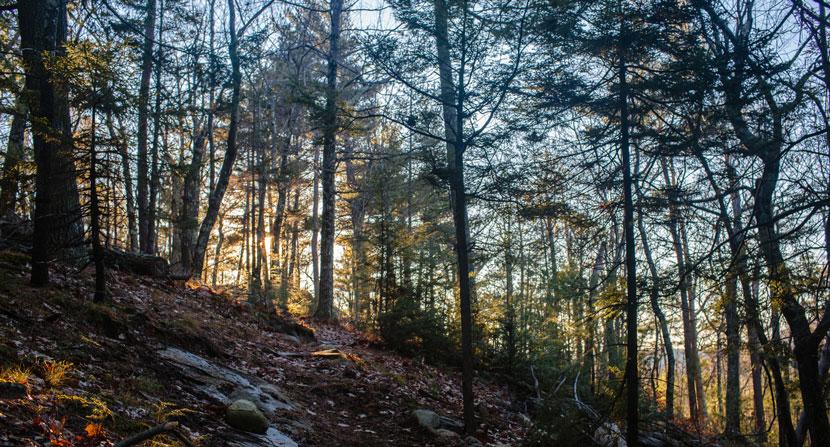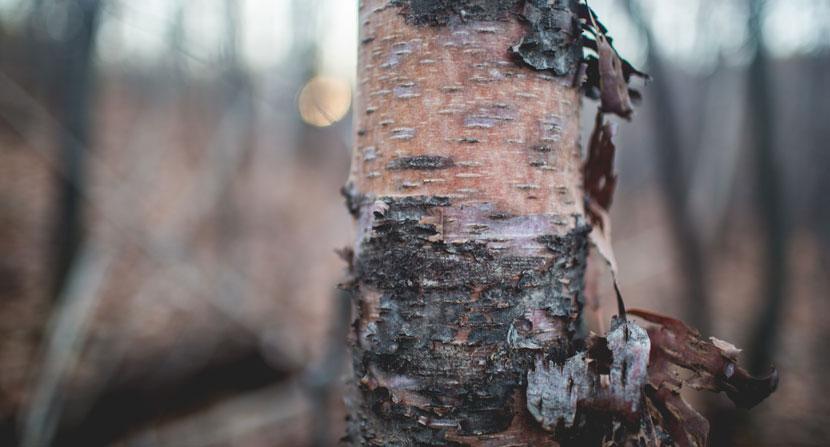Daylight Saving Time is a reminder that winter is on the way

Late autumn sunlight makes a hemlock-lined section of trail glow bright at Moose Mountains Reservation in Middleton and Brookfield. All photos by Emily Lord.
For some of us, “fall back” means an extra hour of sleep to savor. Those of us who rise early are grateful for a little more daylight in the morning. Daylight Saving Time is also a reminder that winter marches closer.
Commuters will lament their wholly dark journeys until the daylight hours creep back after Dec. 21.
I always forget how many gray, rainy days this season brings. They cause me to pause and slow down. I take more time to reflect, rather than act.
I’ve learned to cope with the gloom and impending darkness by looking on the bright side of late autumn. When the sun eventually comes out after a stretch of overcast days, I look around to see New Hampshire’s wooded landscape transformed.
When the sun appears, it lingers low in the sky, never reaching the full zenith it does in mid-summer. Light penetrates deeper into the forest and dances with the soft green branches in a hemlock grove.
Tall oaks cling to their crown of rust-colored leaves that look ablaze in the morning light. These are little reminders that darker days are not without pleasant surprises.
After a recent frost, I watched deciduous trees shed their leaves in droves and wondered, how do northern trees tell when the seasons change? Do cold temperatures or the shifting angle of the sun provide a clue?
Not exactly.
Temperature simply varies too much and sunshine can go away during weeks of cloudy weather.

Trees have a built-in timekeeper called a circadian clock, which measures time using a 24-hour-cycle.
This is surprising because northern trees more noticeably follow a seasonal, not daily schedule.
Heinrich notes that in the tropics, it might be important for some trees to coordinate their blossoms with the daily or nightly schedule of a certain pollinator, but doubts that similar cycles exist in northern trees.
In New England, trees measure the photoperiod or time between dawn and dusk (and vice versa) to determine when to bud and bloom. Imagine that. What tempts me to crawl into bed as soon as I finish dinner also helps trees hold onto their buds until spring.
Changing seasons affect trees’ bark as well as their buds. According to Michael Wojtech, author of “Bark: A Field Guide to Trees of the Northeast,” you can find a layer of green cork skin by scraping away the thin outer bark on a sapling, twig or young branch of pretty much any northeast tree. The signature green from the chlorophyll in the cork skin gives us a clue that photosynthesis is happening in the bark.
For most trees in the northeast, however, the thick bark on the trunk and branches block most or all of the sunlight required for bark photosynthesis.
A few species have thin enough bark that lets sunlight through. American beech is the only tree in the northeast that has smooth bark when it’s full-sized. Wojtech describes its outermost bark as a “fine, almost imperceptible dust” that allows sunlight to penetrate its trunk.

Our northern forest is in relationship to darkness as much as it is the light. The cycle of dormancy is important for northern trees’ survival just as it’s important to find ways to access that energy-giving light.
As my own body and mind adjusts to seasonal changes, I’m comforted by the fact the trees are on the same schedule. When darkness gets me down, I only need to take a moment to look around and appreciate the ever-changing forested landscape.
Emily Lord manages the Society for the Protection of New Hampshire Forests’ online and social media presence. Forest Journal runs every other week in the New Hampshire Sunday News. Reach Emily at elord@forestsociety.org or on Instagram/Facebook @forestsociety.
